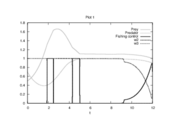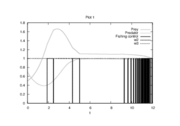Difference between revisions of "Lotka Volterra Multimode fishing problem"
ClemensZeile (Talk | contribs) |
ClemensZeile (Talk | contribs) |
||
| Line 44: | Line 44: | ||
== Reference Solutions == | == Reference Solutions == | ||
| − | If the problem is relaxed, i.e., we demand that <math>w(t)</math> be in the continuous interval <math>[0, 1]</math> instead of the binary choice <math>\{0,1\}</math>, the optimal solution can be determined by means of | + | If the problem is relaxed, i.e., we demand that <math>w(t)</math> be in the continuous interval <math>[0, 1]</math> instead of the binary choice <math>\{0,1\}</math>, the optimal solution can be determined by means of direct optimal control. |
| − | The optimal objective value of | + | The optimal objective value of the relaxed problem with <math> n_t=12000, \, n_u=400 </math> is <math>x_2(t_f) =1.82875272</math>. The objective value of the binary controls obtained by Combinatorial Integral Approimation (CIA) is <math>x_2(t_f) =1.82878681</math>. |
<gallery caption="Reference solution plots" widths="180px" heights="140px" perrow="2"> | <gallery caption="Reference solution plots" widths="180px" heights="140px" perrow="2"> | ||
| − | Image: | + | Image:MmlotkaRelaxed_12000_30_1.png| Optimal relaxed controls and states determined by an direct approach with ampl_mintoc (Radau collocation) and <math>n_t=12000, \, n_u=400</math>. |
| − | + | Image:MmlotkaCIA 12000 30 1.png| Optimal binary controls and states determined by an direct approach (Radau collocation) with ampl_mintoc and <math>n_t=12000, \, n_u=400</math>. The relaxed controls were approximated by Combinatorial Integral Approximation. | |
| − | Image: | + | |
| − | + | ||
</gallery> | </gallery> | ||
Latest revision as of 13:16, 21 December 2017
| Lotka Volterra Multimode fishing problem | |
|---|---|
| State dimension: | 1 |
| Differential states: | 3 |
| Discrete control functions: | 3 |
| Interior point equalities: | 3 |
This site describes a Lotka Volterra variant with three binary controls instead of only one control.
Mathematical formulation
The mixed-integer optimal control problem is given by
![\begin{array}{llclr}
\displaystyle \min_{x, w} & x_2(t_f) \\[1.5ex]
\mbox{s.t.}
& \dot{x}_0 & = & x_0 - x_0 x_1 - \; \sum\limits_{i=1}^{3} c_{0,i}\; x_0 \; w_i, \\
& \dot{x}_1 & = & - x_1 + x_0 x_1 - \; \sum\limits_{i=1}^{3} c_{1,i}\; x_1 \; w_i, \\
& \dot{x}_2 & = & (x_0 - 1)^2 + (x_1 - 1)^2, \\[1.5ex]
& x(0) &=& (0.5, 0.7, 0)^T, \\
& \sum\limits_{i=1}^{3}w_i(t) &=& 1, \\
& w_i(t) &\in& \{0, 1\}, \quad i=1\ldots 3.
\end{array}](https://mintoc.de/images/math/d/a/d/dad7be9264b08357bd97039bd5e954d2.png)
Here the differential states  describe the biomasses of prey and predator, respectively. The third differential state is used here to transform the objective, an integrated deviation, into the Mayer formulation
describe the biomasses of prey and predator, respectively. The third differential state is used here to transform the objective, an integrated deviation, into the Mayer formulation  . This problem variant allows to choose between three different fishing options.
. This problem variant allows to choose between three different fishing options.
Parameters
These fixed values are used within the model.
![\begin{array}{rcl}
[t_0, t_f] &=& [0, 12],\\
(c_{0,1}, c_{1,1}) &=& (0.2, 0.1),\\
(c_{0,2}, c_{1,2}) &=& (0.4, 0.2),\\
(c_{0,3}, c_{1,3}) &=& (0.01, 0.1).
\end{array}](https://mintoc.de/images/math/7/3/d/73dd5018bea7b43a28e8854d28fc9436.png)
Reference Solutions
If the problem is relaxed, i.e., we demand that  be in the continuous interval
be in the continuous interval ![[0, 1]](https://mintoc.de/images/math/c/c/f/ccfcd347d0bf65dc77afe01a3306a96b.png) instead of the binary choice
instead of the binary choice  , the optimal solution can be determined by means of direct optimal control.
, the optimal solution can be determined by means of direct optimal control.
The optimal objective value of the relaxed problem with  is
is  . The objective value of the binary controls obtained by Combinatorial Integral Approimation (CIA) is
. The objective value of the binary controls obtained by Combinatorial Integral Approimation (CIA) is  .
.
- Reference solution plots

